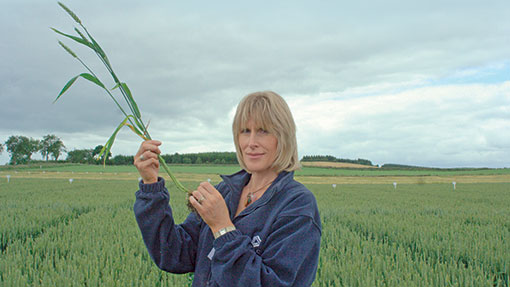Mixed approach best to fend off cereal disease

A slightly higher spend on fungicides, together with close attention to both spray timings and rates, has been successful at keeping septoria at bay this year on the milling wheats grown by G Horn & Sons at Droxford, Hampshire.
With Group 1 and 2 winter wheat varieties, Crusoe and Panorama, being produced for local milling markets, grower Stephen Horn believes septoria control has become a greater challenge in recent years, and has amended his agronomy and variety selection accordingly.
See also: Research sparks new approach to cereal disease
“This is the first year we’ve grown Crusoe, which replaced long-standing Solstice,” he says. “The reason for making the change is that we were getting more worried about the levels of disease in Solstice, so decided to see if we could make better use of varietal resistance.”
His Group 2 stalwart, Panorama, which has performed very well on the farm for a number of years, will be replaced by the new provisional Group 1 Skyfall this autumn, he adds. “Skyfall looks very promising. As we have access to good Group 2 markets, it won’t matter if it doesn’t turn out to be a true Group 1.”
Working closely with his agronomist, Mr Horn has started his disease control programme with a T0 spray for a number of years, believing it plays a key role in staying ahead of disease.
“This year was no different,” he recalls. “We had a mild winter, so there was already disease in the bottom of crops in March.”
As a result, he used a more robust T0 than in previous seasons. “I still had the terrible year of 2012 in mind, so I spent a bit more on this first-spray timing. And as it has turned out to be a high-disease pressure year, I have no regrets.”
It was applied on 19 March, when a Brutus/chlorothalonil mix was used – the chlorothalonil at a rate of 1 litre/ha and the Brutus at 0.75 litre/ha.
“The combination of the two triazoles – epoxiconazole and metconazole – in Brutus covers more strains of septoria than using one and helps to protect the following chemistry.”
Just three and a half weeks later, the T1 spray went on, he says. “The weather wasn’t very good in the middle of April and I would have preferred to go on a bit earlier. Fortunately, the timing proved to be OK.”
This year, he opted for a new-generation SDHI at T1, using bixafen-based Boogie Xpro with the multi-site protectant Phoenix (folpet). That was a change to his normal practice, as previously his policy had been to use a triazole-based T1 spray.
“We have spent a bit more on both of the varieties and that additional expense has been at the earlier timings,” he acknowledges. “It seems to have been the right approach, especially as we had no need for a T1.5 spray.”
He adds that even though the main focus is on septoria, the programme used also offered good rust activity. “Crusoe and Panorama have good resistance ratings to yellow rust, so it is less of a concern, but we can’t be complacent.”
The T2 or flag leaf spray was applied on 7 May, three weeks later, with the two varieties having slightly different approaches. The 95ha of Panorama received 1 litre/ha of Imtrex, together with 1.25 litre/ha of Brutus, while the Crusoe had 1.5 litre/ha of Boogie Xpro.
“That reflects the higher disease resistance scores of Crusoe,” explains Mr Horn.
At T3, on 1 June, Kestrel was applied at 0.6 litre/ha. “We’re growing milling wheats, so we need to guard against fusarium and any development of mycotoxins. The prothioconazole component of Kestrel is important for that.”
That application completed the disease control strategy and he was able to close the gate. “Of course we used other inputs, such as growth regulators and trace elements, throughout the growing season and according to need.”
Both varieties have remained very clean and he is optimistic about their harvest potential. “The target is for 600 ears/sq m and we’ve got some enormous ears on the Panorama, with four or five grains/spikelet. Our agronomist, Iain Richards of Agrii, rubbed 81 grains out of a single ear the other day.”
The farm’s five-year wheat yield average is 10.2t/ha, which includes 2012 when yield were down to 7.9t/ha. “Like many others, we do seem to have hit a yield plateau. With the chemistry and varieties that are available, it should be possible to hit 15t/ha.”
Mr Horn calculates that he has spent £120/ha in total on fungicides this year. “That’s up from £112/ha in 2013, which was a lower disease season. But in 2012, we spent £130/ha, as we had to use a T4 spray.”
The 2012 experience convinced him of the need for a more robust approach at T0. “We know that we’ve lost some of the eradicant activity of the triazole fungicides, so we have to be working in a protectant manner for best results.”
The same year also reinforced the need for accurate spray timings and robust rates. “We’re expecting a great deal from these fungicides, so we much use them in the best way and make sure that we’re not putting them at further risk from resistance.”
